Serendip is an independent site partnering with faculty at multiple colleges and universities around the world. Happy exploring!
BSIE 2010: Session 13

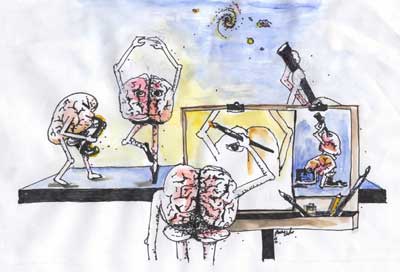 |
Brain, Science, and Inquiry-Based Education
|
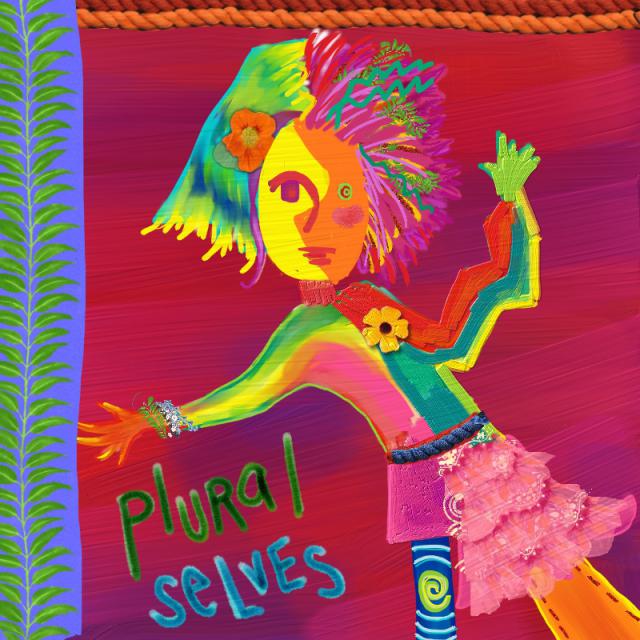 |
The Bipartite Brain, a Second Loop
Picking up from yesterday
I liked the notion of success being reached by trying things out without knowing whether they will work or not. This idea also ties into the notion of students being uninhibited in the classroom and feeling free to experiment. I'm very familiar with working this way since theatre and drama involve experimentation and getting things wrong without the burden of feeling embarrased or being made fun of. It's all about observing and making new observations as we go along. ... cdivo9
Learning is a process of trying new things and seeing if they work. If they don't work, you must try out another idea and reshape your observations. ... Shoshana
???????
The brain as an empirical inquirer - Loop 1
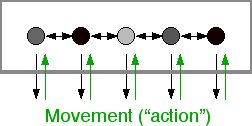 Learn by interacting with the outside world, noticing differences between expectation and input
Learn by interacting with the outside world, noticing differences between expectation and input- No thinking, uses randomness
- Always operating, better than thinking under many circumstances
- Thinking needs to affect it to have long-lasting effects
The bipartite brain and a second loop (conversation between unconscious and conscious, "reflection")
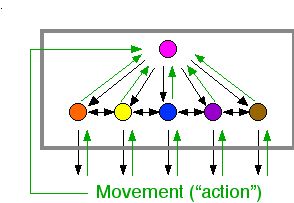
- Learn by interacting with the inside world, noticing differences between unconscious and conscious understandings.
- Consciousness helps one integrate various unconscious understandings
- Consciousness helps one deal with circumstances that the unconscious can't deal with
- Consciousness helps one to exchange understandings with other people
- Consciousness helps one to conceive new possibilities, things the unconscious wouldn't have conceived
- Both the cognitive unconscious and consciousness are valuable but the real power is in the loop between them, the testing one against the other
Uncovering the cognitive unconscious - an informed guesser, observations as constructions
Reflection - learning to use a conversation between the cognitive unconscious and consciousness, the I-function, story teller
- Ambiguous figures, getting beyond informed guessing
- Creating what hasn't been (as, for example, gravity, curved space-time)
- Being an influence on one's own behavior (as, for example, learning to become a better conversationalist)
- "Understanding" as (temporary) agreement between various understandings, rather than knowing "reality" (see also Bird brains and the Monty Hall Dilemna)
A third loop: conversations between people, looking for differences
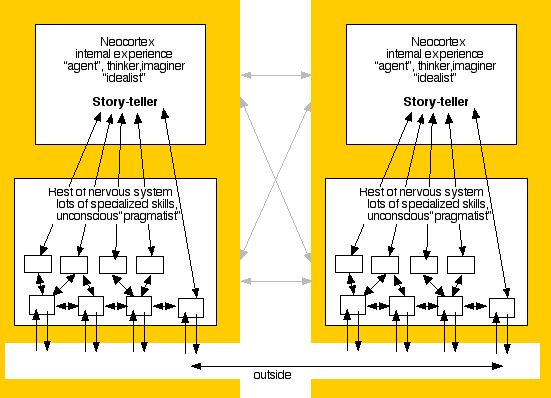
Interpersonal interaction, conversation, can enhance diversity, can also inhibit it
And a fourth: society/culture as collective stories that individuals can both contribute to and draw from, again looking differences
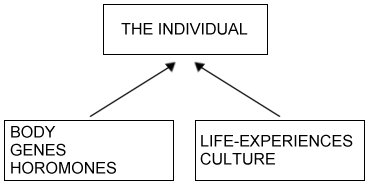
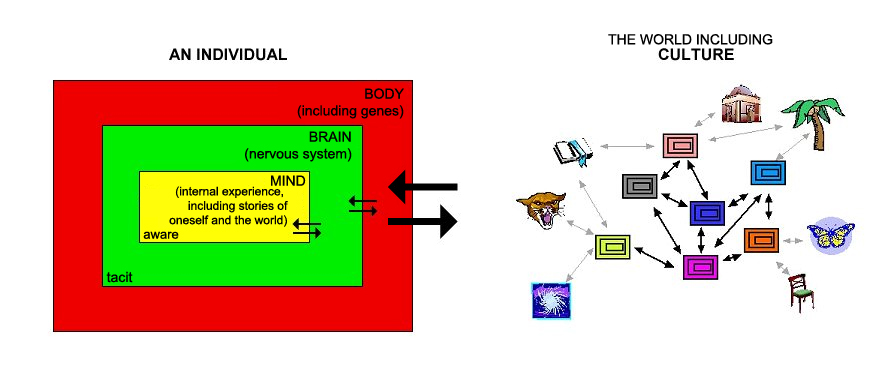
from The Brain and Social Organization
Interacting individual and cultural stories, can promote diversity, can also inhibit it.
Bottom line: we learn by noticing/valuing differences within ourselves, between ourselves and the world, each other, and society/culture, using them all to construct new understandings for ourselves and to share with others. Life should be a conversation, a co-construction, rather than a competition



Comments
The Conscious and the Unconscious
The conscious appears to be the deliberate thinker and planner, while the unconscious does more "acting" without all the planning. The brain is always interacting between the two. Both constantly interact with the world. The unconsciouness is more prone to guessing and exploring, while the consciousness tries more to understand and explain. Optical illusions lend to the saying, "My mind is playing tricks on me." A clearer understanding of the cognitive unconscious makes it easier to undersatand some interesting inconsistencies like optical illusions.
The Brain session 13
One would believe after a session like we just had that reality is questionable. the conscious and unconscious state of the brain is remarkable assuredly when you discover the two work together in a odd way to conclude and restore.
How important is it for our student to learn in a structured environment? It is far to important for our student to learn then for our class rooms to be structured. We can not become so enthralled in right and wrong out comes, but become more interested in the outcome itself.Also in what the student learned from it, even if there is a right or wrong in the book we must teach to go beyond the book.
Creating Conflict....a Good Thing
I am thinking of concrete ways to activate the unconsious in the learning proccess...how to create disequalibrium in productive ways. I take any suggestions.
Concscious Unconscious con't.
The differences between expectations and input create learning! Unless what you learn gets into the unconscious, it disappears! So my students will have to deal with a conventional teaching approach at the beginning of the year as I work out how to effectively control classroom behavior. Once we find we are both on the right track, we will learn through exploration and inquiry. Maybe the combination of both formats will create pathways in the brain that will promote learning. "Just because we all see things differently doesn't mean we can't come to a social concensus."
Remember me: The unconscious brain
Each year as we begin our discussion of energy transfer in biological systems, my Middle School students tell me that plants need food. For many years, I have discussed with them the title of plant food given to the boxes of fertilizer they see in the supermarket. I ask them to describe what food means to them; they list corn chips, salad, pizza, tacos, hummus, and other foods they eat. For an assighment, I ask them to keep a three day diary of all the food from plants that they eat and list the part of the plant from which it comes, root, stem, leaf, flower, or seed. At the end of the three days, the students are surprised at how much they depend on plants for food. Then we discuss how plants become food using the story of photosynthesis. Students tell one another the story, they manipulate papaer atoms to play out the chemical process and then use ball and stick chemical models to reinforce the process. They engage in many experiments to support the story. Still, at the end of the year, an occasional student will announce during class discussion that plants need food.
Paul suggested that the story, plants need food, may be a one from the unconscious brain. His observation started me thinking that the story of absorbing nutrients is a powerful one for survival. The villi in the small intestine are responsible to absorb the digested nutrients we use for building blocks for growth, replacement, and repair. These nutrients yield energy stored in their chemical bonds for cellular work. The unconscious brain directs the search, ingestion, digestion, absorption, and distribution of new matter to the cells of our body. If humans need food, why shouldn't other living things? Paul's comment offered me valuable input to rethink how I will initiate the conversation of energy transfer in biologically systems. I will start out with the same approach and engage the students in conversation, experimention, and reflection. This year I will ask the students more pointedly to explain from what source the matter comes for the sugar molecules produced as a result of the photosynthetic process. I thought manipulating the ball and stick models was enough for them to understand that the carbon for the sugar comes from carbon dioxide, but I understand that to revise the story in their unconscious, some students will have to also verbalize the connection. Perhaps, I will assign them to write a story about how sugar is made by plant and also ask how plants obtain the other matter needed to make other compunds such as proteins. In this way, I will not be inhibiting them from drawing on the knowledge and experience of thier unconscious brains. Of course, this will take time, so some other less interesting topic will be abandoned for the moment.
Note: This is my third Institute, and as I become a better teacher, I find that I teach less content and teach more an approach to learning.
Wow Susan. I think your
Wow Susan. I think your final note is very profound and has implications for all of us. I think to a degree I feel the same way, but never used that as a reflective process for myself as a learner. Great food for thought.
conversation between the cognitive unconscious and consciousness
I think I understand better the process of "thinking". The on-going conversation between the unconscious and the consciouness is not only my"thinking" process, it is also a reflection on how I interact with others. Perhaps the struggle I have with communicating (wanting to, but is very reluctant) has more to do with the internal conflict in my brain. How does my concsiousness make my unconcscious believe that it is safe for me to share more of my thoughts and experiences? It isn't just a matter of doing it. In numerous formats I have been very open about myself to others. Yet my unconscious mind view these occassions as isolated incidents and not to be view as an appropriate behavior in everyday life. While I "understand" the inconsistency of that last sentence, I still struggle to incorporate being more verbal into my daily life.
The above also reflects on the need for students to have multiple occassions through-out the day to contribute their thoughts and experiences to others (and receive validation). If a child is expose to this on a consistent basis, that child will more likely continue to develop into an adult engaged in his/her world.
Conscious and Unconscious
Diversity seems to be the only constant that exisists in reality as I see it. The diversity that exists even within the conscious and cocnitive unconscious is a diversity that has not only personal implications, but cultural as well. The idea that so many people can see, interpret, and convey such different understandings of thier world, but come to some kind of idealism that says "we can agree" is very inspiring and motivating. I truely like this idea we have come up with about being not wrong but different. I feel as though this will help me as a teacher to help alieviate students' feelings of anxiety when it comes to group contributions. But on a personal scale, it has also helped me to understand and identify some biases I have as an individual and to understand what role they may be playing in communication. I have found that even in this short time we have spent in the institute that I have become more flexible and try to fight the urges I get to discount others' ideas and thoughts in preference for my own personal experiences and observations. I have been more receptive and in fact welcome more of what others have come to offer than I have before. I only hope that as time goes by I don't slip back into old rutines and fall out of practice. I think that I have identified the idea that this will be a conscious effort in the beginning to avoid this regression back to old, hard wired practices and that I will have to work to train the unconscious.
Reflections of what is and what isn't
This morning session was very interesting to me because I have come to realize that my mind is playing games with me and that my unconscious is sometimes more in control than I would want it to be but I realize that in order for myself to be myself I have the final say in this story. If I want to take things for face value then I can but if I don't I will work it out with my unconscious. I like the conservation of being able to converse with myself and sometimes I am glad my brain fills in the missing pieces. I like the idea of "altered thinking". This gives me a lot of things to help me stimulate and create and direct my thinking not only as a teacher but also a person.
Concscious Unconscious
I want to let my new students interract with science without any judgement, except that they record their findings!
7/20 AM
Learning by interacting with the inside world is no different between conscious and unconscious.
Consciousness gives us the ability to think and create.
New things come out of sharing. When everyone feels trust, we make new things.
We are learning to value ourself and the world with people and culture. With this understanding we can create new understanding and are able to share with each other.
We are learning, inside the brain, by knowing the difference between conscious and unconscious understanding.
2nd Tuesday AM
Our unconscious is really smart!
Not being judged, but rather valued, leads to even more discoveries; that are even more positive and even deep.
One of the best ways I have found to understand differences, is to have ice breakers using ambiguous figues and other similiar resources. These are great professional development tools.
Unconscious/Conscious
Very interesting dichotomy this notion of the conscious and unconsious. I like the fact that a differences are set up so that we may see something productive, and therefore see a conflict that we have to find a solution for. This helps me to understand the process a lil better. Could we understand this to be multiple interpretations...the communication between the conscious and the unconscious?
Post new comment